Others date it back to Chinese prehistoric times when inhabitants of the Great Plain created special superstitions which, together with their primitive beliefs, gave origin to Feng-Shui because they needed to find something to protect them from death and other misfortunes caused by invisible and secret forces.
Finally, because the Chinese geomancer uses a set-square to mark three points of one hundred and twenty degrees on the horizon, Edkins thought that Feng-Shui had its origin in Greece and then reached China through Western Asia (Anatolia), Persia and India. In this country, Feng-Shui infiltrated the various branches of Vedantic philosophy and later reached China after Buddhism spread throughout the Far East.
It is unquestionable that Buddhism, with its philosophy full of valuable contributions from Greek culture, enriched Chinese geomancy. However, it is also known that the Chinese made use of Feng-Shui many centuries before Buddhism was introduced in China.
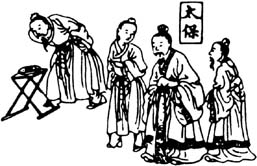 The ritual order is fixed: first, the walls are erected as they are the most sacred section of the town. After that, the ancestors' temple is built. At the same time, trees must be planted to offer fruit to the ancestors and to make coffins.
In ancient times, when the capital's plan was drawn, the highest point was always selected to build an ancestral temple and the most dense trees were chosen for the sacred forest. Only after the walls and altars had been completed and trees had been planted, could palaces and houses be built.
The dignity of a lord and his town was indicated by the walls. These walls were made of compacted mud or adobe if the village did not include the ancestral temple for the prince's forefathers. If that was the case it was called 'Yi' ('settlement') rather that 'Tsong'. A true town had its walls made of masonry and in this case it was called 'Tu' (capital).
This is some of the oldest and most reliable evidence about ceremonies held in ancient China aimed at founding cities or towns in a selected place, with walls, an ancestral temple and a sacred forest. It also describes the proper time to start and finish any construction, as well as the relevant inauguration.
All these customs and rituals are dictated by the dual manifestations of Yin-Yang (the two cosmic forces that guide the Universe). They are used to locate places and determine times based on religious factors, and help us to find out the origin of the famous art of Feng-Shui. With the combinations and interpretations of the I ching's hexagrams (the Book of Changes) and alterations by the beliefs and customs of primitive naturalism and ancestral cult, Feng-Shui appeared as a strange system of pseudoscientific superstition in the era of Chinese alchemy, early in the Ch'in dynasty (255-206 BC). During this period, the magical-astrological Taoism reached its peak, personified by Emperor Ch'ih-Shi Huang Ti himself.
After that, Feng-Shui became deeply rooted in the Chinese spirit, as people believe that there are forces acting upon natural phenomenon and man-made buildings. They also believe that even the most simple thing has a bad or good influence upon the living and the dead. Therefore, Feng-Shui's objective is to find out the locations with good influences. If a place features bad influences, Feng-Shui tries to reverse them by artificial means in order to achieve auspicious results.
Among the factors that Feng-Shui takes into consideration are: Yin and Yang; Ch'i, the vital energy that invades the Cosmos and affects all the universe, divided into T'ien-Ch'i ('heavenly vital energy') and T'i-Ch'i, ('earthly vital energy') the Four Mystical Beings (the azure dragon, the white tiger, the red bird and the black turtle) which are related to the four cardinal points; the wind that brings or dries water with its surface and underground currents; the five traditional elements (metal, earth, fire, water and wood, especially water with its volume, movement and flow which is seen always in relation to the mountains) corresponding to the Five Planets (Venus, Saturn, Mars, Mercury and Jupiter); the four seasons and the dates of a division of the year following fortnightly periods adjusted to the solar calendar.
The ritual order is fixed: first, the walls are erected as they are the most sacred section of the town. After that, the ancestors' temple is built. At the same time, trees must be planted to offer fruit to the ancestors and to make coffins.
In ancient times, when the capital's plan was drawn, the highest point was always selected to build an ancestral temple and the most dense trees were chosen for the sacred forest. Only after the walls and altars had been completed and trees had been planted, could palaces and houses be built.
The dignity of a lord and his town was indicated by the walls. These walls were made of compacted mud or adobe if the village did not include the ancestral temple for the prince's forefathers. If that was the case it was called 'Yi' ('settlement') rather that 'Tsong'. A true town had its walls made of masonry and in this case it was called 'Tu' (capital).
This is some of the oldest and most reliable evidence about ceremonies held in ancient China aimed at founding cities or towns in a selected place, with walls, an ancestral temple and a sacred forest. It also describes the proper time to start and finish any construction, as well as the relevant inauguration.
All these customs and rituals are dictated by the dual manifestations of Yin-Yang (the two cosmic forces that guide the Universe). They are used to locate places and determine times based on religious factors, and help us to find out the origin of the famous art of Feng-Shui. With the combinations and interpretations of the I ching's hexagrams (the Book of Changes) and alterations by the beliefs and customs of primitive naturalism and ancestral cult, Feng-Shui appeared as a strange system of pseudoscientific superstition in the era of Chinese alchemy, early in the Ch'in dynasty (255-206 BC). During this period, the magical-astrological Taoism reached its peak, personified by Emperor Ch'ih-Shi Huang Ti himself.
After that, Feng-Shui became deeply rooted in the Chinese spirit, as people believe that there are forces acting upon natural phenomenon and man-made buildings. They also believe that even the most simple thing has a bad or good influence upon the living and the dead. Therefore, Feng-Shui's objective is to find out the locations with good influences. If a place features bad influences, Feng-Shui tries to reverse them by artificial means in order to achieve auspicious results.
Among the factors that Feng-Shui takes into consideration are: Yin and Yang; Ch'i, the vital energy that invades the Cosmos and affects all the universe, divided into T'ien-Ch'i ('heavenly vital energy') and T'i-Ch'i, ('earthly vital energy') the Four Mystical Beings (the azure dragon, the white tiger, the red bird and the black turtle) which are related to the four cardinal points; the wind that brings or dries water with its surface and underground currents; the five traditional elements (metal, earth, fire, water and wood, especially water with its volume, movement and flow which is seen always in relation to the mountains) corresponding to the Five Planets (Venus, Saturn, Mars, Mercury and Jupiter); the four seasons and the dates of a division of the year following fortnightly periods adjusted to the solar calendar.
 phoenix (red), tiger (white) and turtle (black). These four animals correspond to the four colours and four seasons (Spring, Summer, Autumn and Winter). The Chinese sky was divided into four parts, and then subdivided into seven. This section corresponds to the first part (East). </figcaption></figure>
<p>
Thus a favourable place should be protected from the North (from where <I>Yin</I> comes) and open to the South (from where <I>Yang is</I> received); have flowing water around it, but not as close to it so as to take away the good influences, as well as having a natural phenomenon like a hill directed towards the )
Besides, any construction - a pole, a huge sign board or a tall building - may be an obstacle to magic influences, even if situated far away from that location. A straight road or a railroad can also cause damage, since they are likely to help good influences to flow out.
In view of the above, one should take care when selecting a place for construction - a house, public building, temple, shrine, arch, bridge, and so forth. If that place does not comply with the requirements set out by this strange science it should be forsaken, irrespective of its good location and beauty. Then advice is sought from Feng-Shui experts.
If a Chinese finds a place with all the conditions required by Feng-Shui for the construction of anything, he does not have to worry because in that case Feng (wind) means 'wealth' and Shui (water) means 'prosperity', both for him and his family.
When erecting a residence, factors other than the place's good currents should be considered. The Four Cardinal Points should be taken into consideration, as well as the various spirits presiding over every room. These rooms are usually separated from each other by winding courts which protect the four sides of the main building. Thus, the Eastern room is under the protection of Lu-Lung or 'azure dragon'; the Western room is under the protection of Pai-Hu or 'white tiger'; the Southern room has the Chu-Chiao or 'red bird' as its protector while the Northern room has the Huh-Kuei or'black turtle' as its protector.
The dragon hates dirt, water-closets and garbage bins and as such they should not be located in the left wing, otherwise the dragon would be irritated, which would make it prevent the positive influences from flowing freely. On the other hand, the tiger hates the heat and so the kitchen should not be located in the right wing, since this is where the spirit of this feline is located. Besides, the back of this room can never be higher than its front side, otherwise the tiger would have its tail raised. This would mean that it was ready to attack its victims, which in this case would be the residents of the house.
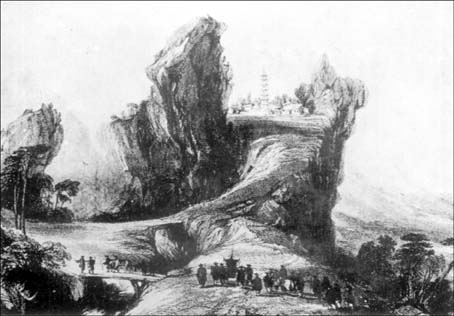 Wutang mountains decorated with geomancy monuments.
Wutang mountains decorated with geomancy monuments.
It is also very important that every hole near a residence should be filled, as this kind of unevenness on the ground could cause the reappearance of Wa-Feng or the 'evil cavern wind'.
Sometimes it is not possible to find a place which meets all the Feng-Shui requirements, especially when they call for the pulling down of valuable buildings or the purchase of expensive neighbouring sites. Having to overcome this, the Chinese, with their practical approach, created a set of subterfuges to elude or counterbalance the evil influences that affect the places where they want to live or erect a building.
Thus, if the place is not very good, its Feng-Shui can be improved by making a well and covering it with the sacred lotus flower, raising a small mound, planting some trees or by just placing a statue of a dragon in an appropriate location, since this monster is the only being capable of defeating Sha-Ch'i or 'death spirit'.
Similarly, houses located in blind alleys or receiving evil winds from the street can be protected by placing a small rectangular mirror on the façade in order to ward away the impact.
Where the main door of a residence is facing an evil side, bad luck can be avoided by building a winding access to that door, since evil influences such as the light are projected in a straight line.
Houses with bad Feng-Shui are those located between taller buildings and when the eaves and corners of the surrounding buildings are pointing towards them, this is a sign of ruin and death for the occupants of these smaller houses. In order to avoid that evil influence, wooden or earthen images portraying warriors with their swords drawn, or lions and tigers with their mouths open, should be placed on the roof of bad Feng-Shui houses. Very often, the occupants of these houses place a small metal trident with its ends towards the eaves and corners of the buildings affecting them in retaliation or vengeance. They also put a small concave mirror inside a Pa-Kua (octagonal image used in I ching fortunetelling) aimed at reflecting the evil caused by the eaves and corners towards those buildings.
With the purpose of not causing any harm to their close or remote neighbours or to themselves, due to mirrors and other protective devices placed on their neighbours' facades or roofs, the Chinese use an old method of building construction used mainly in temples, pagodas or multistorey buildings, whereby people's Feng-Shui is neither affected nor harmed. Therefore, their architecture features very special characteristics: houses feature curved and gabled roofs, while their corners are curled upwards. It is this specific characteristic that makes the Chinese style different from other styles of architecture. However, some say that the abovementioned characteristic originated in the shepherd tents used by the nomads, who subsequently developed into the sedentary Chinese people.
Main doors of residences must be protected by a Yin-Pei, which is a sort of wooden or brick screen to prevent their occupants from being struck by Sha-Ch'i or the 'evil wind from the alleyway'. Where there is an alley or winding passage near or in front of the main door, the Chinese say that it invites the An-Chin or 'secret arrow' (a type of wind feared for its evil effects). This wind can be countered by the placing of one or two stone, marble or bronze lions. Most of the time, these lion statues found at the entrance of temples, palaces, wealthy residences and public departments feature on their pedestal inscriptions proclaiming the magic force that lions are capable of using to fight An-Chin. Those who cannot afford to have a lion statue hang signboards or red paper strips reading T'ai-Shan-Chih-Kan-Tang which means 'inflexible like the great T'ai-Shan' (Taoism's sacred mountain) at their thresholds.
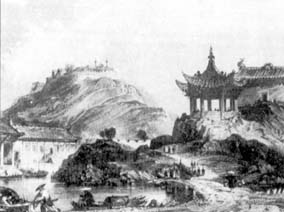 Terror Fortress (Ting-hai, Xusan) built in a place with good Feng-Shui. The octagonal Ancestors Temple is to the right.
Terror Fortress (Ting-hai, Xusan) built in a place with good Feng-Shui. The octagonal Ancestors Temple is to the right.
Very often, the Chinese place on their main door lintel the Pa-Kua image, a magic octagonal symbol which is believed to have powers to fight away any evil influence. People say that this symbol was copied by Fu Hsi (the first of the three mythical emperors who ruled approximately in 2852BC) from the back of a dragon-horse which emerged from rough waters while he was meditating at the seaside.
The construction of a small temple to protect a larger one is also very common, as the small one can improve the latter's Feng-Shui providing it has the appropriate location. In certain cases, a stone arrow pointing in the direction from where the An-Chin is supposedly coming, is installed in order to eliminate this wind's evil influence.
In order to protect large groups of temples, palaces, imperial tombs, cities and entire districts, a pagoda or tower with odd floors (Yang number) is built in a proper place to enable it to overlook the buildings or the region under protection. This pagoda acts like a Chen-Wu or 'protector' and it is believed that it eliminates or counterbalances the An-Chin and other evil influences by means of its beneficial radiation. Being included in the landscape, most of the time it emphasizes and complements it.
For the very same purpose, trees are planted 'which fruits will be offerings to ancestors and those which are good for making coffins and sound boxes', in accordance with Shih-ching. Therefore, when one sees a forest in China, one knows that there is a village nearby, since trees make up for the 'sacred forest' which protects its inhabitants from evil influences blown in that direction.
Feng-Shui is also used to determine the direction of tombs since the Chinese believe that human beings have two souls: the Ming (included in the Yang cosmic element) which is purified in the various reincarnations until it is absorbed into Tao's complete eternity; and the Kuei (included in the Yin cosmic element) which returns to Earth from where it originated.
When Ming is in the living body it is called Hei (vital breath) and it is transformed into Shen (radiant spirit or god) when the body passes away. When the body that houses it is alive, Kuei is known as P'ah and after its death it lives in the tomb or drifts in the places it used to go when it was alive, until it matures and disappears into the Earth.
The Chinese believe that jade and pearls as well as beneficial influences blowing from West to East prevent corpses against decomposition. In view of this, the Feng-Shui principles that govern the construction of a grave are different from those concerning the construction of houses, temples, palaces, and so forth.
Finally, the Chinese believe that in return for the peace that they might be able to offer to the corpse and the earthly soul of their dead ones, their deified deceased will give them and their relatives prosperity. Therefore, the Chinese pay much attention to the construction of graves. Choosing the location is a very delicate exercise and neither the deceased's will nor his family's are taken into consideration, since the Feng-Shui expert's criteria and choice play the most import role in this decision. They all accept his decision as they fear that, by letting their personal opinion be known, a place might be chosen which is likely to jeopardize the clan's prosperity, thus causing the ruin of the family and consequently preventing their descendants from any benefits arising out of their filial devotion.
This is why the Chinese frequently spend most of their lifetime savings in the construction of graves as they are the place where coffins are kept and some time later they also keep the urn containing the bones of the deceased.
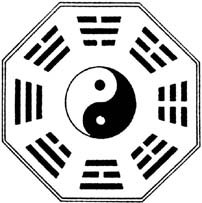 Pa-Kua, the eight main trigrams. The circle with Yin/Yang is in the centre. This is the creation symbol with its development.
Pa-Kua, the eight main trigrams. The circle with Yin/Yang is in the centre. This is the creation symbol with its development.
When the family cannot afford such costs, it mortgages its property. But if it owns no property, quite often the daughter commits the Mai-Sin sacrifice by selling herself as a concubine or slave. With the proceeds of the sale, the family will be able to perform this sacred ritual. With regard to filial devotion, the history of China features many cases of children, both male and female, selling themselves in order to be able to bury their parents with some dignity.
According to Feng-Shui, high lands are called Lung (dragon) while low lands are Shui (water). Therefore, the best place to build a grave should be located in the middle of a slope, between hills, with one hill on the right where the spirit of the 'azure dragon' supposedly lies (East side), and one on the left where the spirit of the 'white tiger' (West side) lies.
As to the nature of the soil, the best is the Chu-Sha-Ti (vermilion or red earth), because it is very dry and protects corpses from decomposition which makes the earthly soul of the deceased happy.
The Han-Lung-ching, the book most commonly used by Feng-Shui experts, states that the 'azure dragon' feeds from the right side with the cosmic fluid Yang. The 'azure dragon' absorbs this fluid in the shape of sunbeams which return at night converted into Yin emanations in the shape of moon beams, after travelling to the left side under the grave. This continuous coming and going is an auspicious flow.
It also states that both mythical animals - the azure dragon and white tiger - comprise all of Feng-Shui's eolian and aquatic influences. When placing the coffin in the grave, the deceased's head should be facing North, under the protection of Un-Mou or 'obscure warrior', while his feet should be facing South, under the magic influence of Chu-Chiao or 'red bird'. His right and left sides are protected by the 'white tiger' and 'azure dragon'respectively.
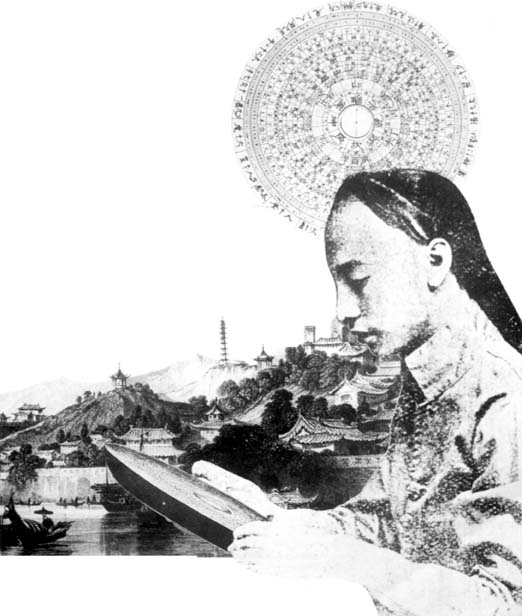 Photo-montage by Victor Hugo Marreiros.
Photo-montage by Victor Hugo Marreiros.
In addition to the above conditions, an auspicious place should be protected against winds, mainly those coming from the North because they are evil. As all winds are bad, even the underground ones, the place should also be protected from local winds.
The Chinese believe that even the most insignificant wind can turn the corpse one hundred and eighty degrees around if that wind blows over or under the grave for twenty years. If that happens, his family will experience a series of misfortunes and ruin. To avoid local winds, there should be no holes, cavities or hollow spaces near a grave because they generate the Wa-Feng or 'evil cavern wind'. The best place should be free from Northern, local and underground winds as well as the Tang-Feng or 'winds blowing from the centre of the Earth'.
In addition to wind, water is also very important in determining the best location for a grave. Therefore, special attention should be paid to the direction of the water flow, the location of its source, places where streams flow into it, and places where the water course is divided or changes direction or angle.
It is said that stagnant water is the source of the worst evil and therefore any water close to a grave should be running or spring water. In addition to the care taken in the location and direction of water which may take away all existing happiness unless it is correctly positioned, the place must feature all requirements for collecting and preserving cosmic and natural influences coming from the stars. To that end, around the grave there should be no topographic obstacle which is likely to stop or carry away those positive influences.
The Chinese believe that one reaches the limit of earth by digging twelve feet deep; if a further eleven feet are dug, then one reaches the 'water kingdom'. Both the 'earth' and 'water kingdoms' have their dragons as protectors and guardians. This is why Feng-Shui, as a science and art, is closely linked to the dragon as this animal is the god of water and wind.
For the Chinese, the dragon is not a purely mythological, antediluvian or unreal being. For them, mountains and rivers are beings, real and concrete metamorphoses of the dragon's spirit. Rivers are winding marks of dragons at rest, while torrents falling from almost vertical escarpments represent dragons climbing to heaven.
In almost every mountain crest the Chinese see the stretched or curved back of a dragon. On the other hand, when mountains descend gradually into the deep sea, the Chinese see the long extended tail of the sacred monster.
Although stagnant water near a grave is not recommended by Feng-Shui, a small pond in the vicinity of a grave may be considered a positive omen if it is taken as the eye of a dragon. This can be decided by watching the grave's surrounding area from a certain distance and height. The pond must represent a small point in the topographic configuration of the dragon in order to represent the eye and give meaning to the whole picture.
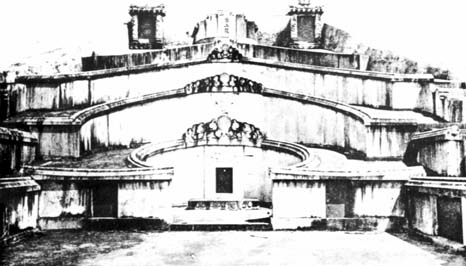 Grave of the Kung family (name of Confucius) built in Fuchow in 1865 with an altar for sacrifices offered to ancestors.
Grave of the Kung family (name of Confucius) built in Fuchow in 1865 with an altar for sacrifices offered to ancestors.
Undoubtedly, Feng-Shui is a superstition full of pantheism, and because of that its concepts give a different view of nature. Such concepts call for the division of the situation and landscape structure to enable to see the same rhythm and shapes of its main animals in the mountain shapes and the places' topograhic configuration. For the Chinese, Nature is alive and has an intrinsic soul. Whatever they look at, they do not see any aesthetic beauty, but a beauty of movement and life instead. For this reason, they believe that locating graves in a beautiful place with mountains, rivers and torrents, dragons, tigers and lions in the background, it is possible to provide the spirit of the deceased with peace and tranquility and consequently give the descendants good luck and prosperity.
Thus, the ideal place for a grave is one that comprises scenery featuring nine dragons, or when five dragons and five tigers (mountains with that shape) unite to pay tribute to the grave. If the deceased is buried in a place with these features it is most certain that one of his descendants will found an imperial dynasty or at least become a prime minister.
If the place's configuration features a Hai-Ti (a piece of land in the shape of a crab), the corpse must be buried without a coffin to prevent the small mouth of the imaginary crustacean, from where good influences originate, from being blocked.
Those who wish to have female descendants for secret reasons, (these cases are very rare) choose a Fung-Ti (a phoenix shaped site) or Hua-Ti (flower shaped site). In old times, those who wished to have beautiful daughters to be given to the imperial harem and who would therefore become rich and famous, would choose these types of sites for burying their dead.
In imperial China, the emperor owned all the good places for burials which were thought to be under cavities or routes that dragons have underground to enable them to go through the domains that Yu-Huang (the Jade Emperor) told them, to look after and keep supplied with water and wind.
Because of the close correlation between the dragon and Feng-Shui, those who study and practice this science are known as Lung-Kia or 'dragon men', commonly called Feng-Shui-Sin-Sang (Feng-Shui masters). The services of these men are requested quite often, especially for their advice on the nature of sites for burials. In view of this, the deceased stays at home for an indefinite period of time until a place featuring all Heaven and Earth's good and evil influences is found. This site must keep the harmony of the Ten Thousand Spirits of Nature as well.
Usually, wealthy families buy a small hill or mountain where proper places for burying their dead are found. Funeral delays, which can range from seven to forty nine days, can also be caused by waiting for the emissaries of Chou-Kung gods to return to earth as soon as they realize they have taken the deceased's soul away by mistake.
The dead are never buried with earthenware vases because the element 'earth' is linked to the element 'fire' and the dragon is disturbed by the latter. They should not wear gold jewels either, because it is a Yang metal (hot) capable of creating all sorts of Kuei (spirits) inside the tomb. Jade is the only thing that is recommended because it is Yin (cold) and thus prevents decomposition and with its brightness it lights up the souls's way throughout the future. It is very common to cover the seven orifices of the deceased's head with jade moulded in the relevant shape. As to the mouth, the jade piece is shaped like a cricket because this is the symbol of reincarnation.
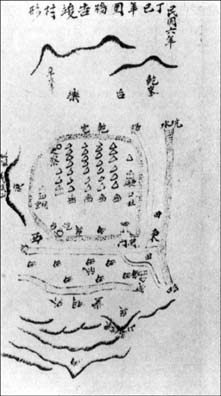 Chart of a geomancy study for the construction of a walled village in China (1917). The chart shows the highest mountains, the cultivation areas, the lake (on the right and dotted) and houses facing South.
Chart of a geomancy study for the construction of a walled village in China (1917). The chart shows the highest mountains, the cultivation areas, the lake (on the right and dotted) and houses facing South.
Feng-Shui masters are also requested to give advice on many family decisions, especially when tomb conditions need to be improved. This can be arranged by planting trees, raising a small mound or redirecting a small stream of water. This is intended to divert or stop any evil influences affecting the place, thus improving the existing Feng-Shui.
Any Feng-Shui can be enhanced as well as weakened or even eliminated. Anything that changes the initial configuration of the site, such as the construction of other graves in the vicinity, the opening of a path or erosion caused by the flow of water, is likely to destroy the site's Feng-Shui benefits. In China, rows between villages are quite common because of that. The very same thing happens between members of clans or families. For instance, when building a grave, the left hand side being the first choice, is reserved for the firstborn son while the right side is for the second-born son. However, this may work the other way round if the site conditions are changed in the meantime. Then, a quarrel will break out within the family until a new and suitable place is found.
Thus, when a village or clan fights for the Feng-Shui of any of their ancestors' graves, they know quite well that they are not defending only the respect and veneration owed to the dead as determined by the ancestral cult; they are also looking after the fortune and happiness of themselves and the whole family. Therefore, it is not hard to understand why these disputes take on such a passionate note and very often the person or clan being affected takes the law into their own hands.
There are countless reports of wealthy and powerful families being financially ruined because one of the ancestors' graves had bad Feng-Shui. Likewise, poor and miserable families have become rich thanks to the favourable location of their ancestors' remains. There are also accounts of cities improving their fortunes with the construction of a bridge or pagoda in accordance with the expert's advice, and of cities entering into decline because of a tall building or mast being built in an inappropriate location.
History reports that when Chao-Ying, the founder of the Sung dynasty (960-1280 BC) was still young and unknown, he was so poor that he had to sell his father's grave. By chance, he then buried his father's remains over a Lung-Mah (dragon's pulse) which is the most suitable place as far as Feng-Shui is concerned. As a result of this, soon after he was able to sit on the the dragon's throne, since the location of the new grave facilitated this event.
This explains why, during the fights for the throne, the main goal of rival parties of factions was to destroy the enemy's ancestral graves as they believed that by destroying their dead ancestor's Feng-Shui, their favours from Heaven would vanish. Conquering dynasties left no signs of their predecessors' graves, except the Ming and Ching dynasties. Despite this raging destruction, China still features the greatest collection of imperial graves known in the world.
Also, if a serious offence was committed, the victims would try to destroy the Feng-Shui of the offending family's grave. In old China, this belief was so important that those who caused the ruin of their enemies by destroying their tomb's Feng-Shui were severely punished, and in many cases they were sentenced to death.
Therefore, Feng-Shui has posed many obstacles to the country's development. Let us take, for instance, the people's rage and opposition when the government tried to introduce the telegraph service and build the first railroad. The lives of directors and engineers were in serious danger because they dared to destroy the Feng-Shui tradition by removing the ancestors's graves of many villages in which telegraph poles had to be erected and embankments built for the railway. The people's discontent was very high and the Manchu imperial government directed the removal of the rails and the destruction of all railway equipment after payment of the total cost, because it feared that a popular uprising would occur if the peace of the dead and the good luck of the living were affected.
Very often, mining was prevented by Feng-Shui; also excavations were discouraged and this resulted in most mineral treasures being still underground, as well as the remains of its old and sublime civilization. The Chinese people resent mining and archeological excavations; in fact, they are against any type of excavation because they think that it will disturb or destroy the magic influences of the region being excavated. They believe that the earth covering a grave should never be disturbed because it is a disrespectful act towards the dead. Furthermore, when the subtle and complex balance of good influences is broken, spirits can be infuriated and in return they can spread plagues and cause death or ruin.
In fact, it is hard not to encounter graves when excavating in China, because the Chinese bury their relatives in specifically chosen places rather than in cemeteries. Besides, a place which is good for one person or family may not be good for another. As a result, graves are a common landscape feature in China, as they can be found on hill and mountain slopes and all across the countryside, thus reducing a great deal the land available for cultivation.
Town planning is also a very delicate and dangerous issue in China. Violent quarrels, due to Feng-Shui, have left their mark on large and small towns. Quite often, real fights between districts in large cities have arisen when some graves or ancestral temples had to be removed because they prevented the expansion of road, for example. Digging trenches for laying drinking water or sewage pipes could also cause rows if such work 'broke the neck' of the dragon which some families trusted to give them prosperity and a chance to taste power. Even cutting a dry tree which enhanced the opposite neighbour's Feng-Shui would cause a row and all these fights would not end unless the problem was solved in a proper way.
Even though most Chinese cities are exotic, they lack variety with their grey walls and roof tops at the same level because Feng-Shui does not allow a taller building to be built opposite a smaller one. Nevertheless, these buildings give us a feeling of peace and serenity, expressing the unification of Man with the Universe.
For the Chinese, a living or dead man cannot exist without his environmental contours or scenery because he is part of Nature. Thus, he must search for his right place and conform to its rules, as well as cooperate and contribute towards the harmonious balance of the local cosmic vital energy.
The Chinese concept of the Universe is based upon the belief that everything that happens, natural and human, is a continuous whole, like a chain of actions and reactions of reciprocal effects which influence their cosmic Trinity: Heaven, Earth and Man. Based upon this ancient belief, the Chinese think that they cannot prosper if they oppose Nature or fight to control it. They can only harmonize with Nature. Those who violate the rules set out by Nature would be considered rebels.
In order to adjust itself to the Universe structure, Feng-Shui sets a series of rules according to which the landscape should harmonize with Nature to bring peace, happiness and contentment to the occupants (living or dead) and help in the cosmic order and balance. This explains the rather peculiar Chinese landscape. Although we take such rules as unintelligible superstitions, the truth is that they are the result of a careful and continuous observation of Nature, as well as a wide and deep vision of Man throughout many thousands of years.
However, Feng-Shui, like any belief involving superstition or cosmic representation, causes intersting cases of fanaticism like the one I am about to tell. Back in imperial times, detachments of the imperial artillery stationed at Canton, had to fire their cannons at Sao-Kao-Leang or Dog Crest, just outside the Western Gate, during the first fifteen days of the eleventh lunar month. This was done annually because Feng-Shui experts foresaw that vapours coming from that mountain would be instrumental in bringing a new emperor into power. Therefore, with the purpose of preventing such a terrible thing from happening, the Manchu viceroys ordered the detachments to fire at the this mountain during the most appropriate time of the year.
Since then, Feng-Shui has suffered a lot due to the continuous confrontation of Western ideas and customs, and the series of reforms directed in 1921 by the Republican Government, aimed at modernizing the country. The current regime has also played a role in this, as it bans and penalizes all those who practice the old customs and superstitions. Roads and railways were built; most of the graves spread in valleys and on hill slopes were removed; artesian and oil wells were drilled; mines were opened; archaeological areas were excavated; electricity and telephone poles were erected and radio and television towers were built; high-rise buildings were constructed and thousands of other constructions were carried out without any consideration whatsoever for the principles and customs of Feng-Shui.
However, beliefs die hard and Feng-Shui still plays a very important role in the Chinese people's lives and its presence can be felt everywhere, despite the efforts made by the Government'to eradicate it. Thus, large and tall buildings ordered by the new regime in large cities both to house workers and bureaucrats and install public services, feature a hybrid style with Western sides, and roofs with corners and eaves curled upwards. Those buildings housing government departments feature two lions at the main entrance and inside they are decorated with dragons, bats, turtles, lotus blossoms, fretworks and other symbols associated with Taoist and Buddhist mythologies and Feng-Shui itself.
Even now, shop owners become very annoyed when a tiger image is placed in front of their shops. When they realize that their opposite competitor has installed an earthenware tiger, they make arrangements for the installation in their shop of an earthenware statue of Un-T'an, a personality in Chinese mythology who was famous for hunting tigers. This is intended to prevent the tiger's invisible spirit from hurting the prosperity of the business.
Also, when a shop is doing well, the opposite shop owner places on the facade of his shop a small rectangular mirror to attract the image of the main entrance of the prosperous shop, so that the good influences and good luck spirits can be attracted by mistake into his shop. The very same procedures apply to houses. If a family is happy and prosperous and enjoying all the conveniences of a good life, or if it is just happy, neighbours install small mirrors directed to its main door in order to attract to themselves some of the prosperity or happiness enjoyed by that family.
On the banks of large rivers in China, especially the Yellow River, there are countless villages and small towns which are periodically flooded and pulled down when the water reaches very high levels. Nevertheless, their inhabitants will never raise the existing dikes, otherwise they would block and divert the magic fluids that benefit the region. Despite the government's efforts to convince people to raise protective dikes and leave Feng-Shui superstitions behind, the fact is that people still drown because they refuse to raise the dikes.
In October 1957, the Portuguese celebrated the fourth centenary of their presence in Macau. In commemoration, the government of Lisbon ordered the construction of a magnificent monument on a hill in the Northern section of the city. This monument was thirty five metres tall and shaped like a triangular obelisk. As one of its edges was pointed towards the neighbouring province of Chung-Shang, its inhabitants complained 'that the blade of that huge knife' was cutting the propitious currents of their Feng-Shui. The government of Peking had no alternative but to demand from the Portuguese the immediate destruction of the monument. The Portuguese complied with this demand and many foreign correspondents interpreted this as an intransigent and hostile act on the part of Mao-Tze-Tung's regime, because they were unaware of Chinese beliefs and customs.
These examples show us that Feng-Shui is still very much alive in China. It is so strong that it is able to change and shape the system itself, because the Chinese follow this thousand years-old belief implanted in their minds, which influences them in all decisions, irrespective of being Marxists or Leninists.
Taking Feng-Shui away from the Chinese would be like removing that exotic 'something' that characterizes both the Chinese and their culture and makes them so different from other people. The Chinese, without Feng-Shui, would no longer be Chinese.
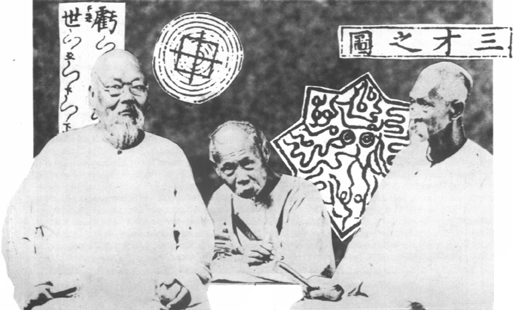
THE PAH KUA
"Pah Kua", meaning "eight trigrams", is a Taoist configuration usually represented by an equilateral octagon. The eight trigrams are the product of all the possible combinations of Ch'ien (a straight line symbolizing Ying) and K'un (a broken line symbolizing Yin) when put into groups of three.
When the eight trigrams are grouped together in pairs, we obtain the sixty four sacred hexagrams. It is believed that all esoteric and exoteric knowledge is contained within these hexagrams and these form the basis for the I ching or Book of Changes.
The T'ai-Chi is a circle formed by two commas inverted against each other and representing the two aspects of Yang and Yin, the masculine and feminine cosmic principles. The black portion represents the masculine, Yang aspect, Heaven, light and fire; the white portion represents the female, Yin aspect, Earth, darkness and cold.
It is believed that these two cosmic forces originated in the chaos of nothing and that they are the universe (i. e. a complete circle), influencing the life and destiny of the "Ten Thousand Beings in Nature".
Nowadays, the Pah Kua, with the T'ai Chi in its centre, is used as an amulet and symbol of good luck and happiness. It is often used as a pendant by women, hanging at the doors of homes and on signboards outside businesses in China.
It is also used as a decoration for damasks and fine porcelain and as a motif on gifts exchanged during festivals and other celebrations.
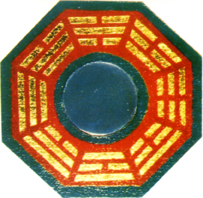
style='font-size:7.5pt;mso-bidi-font-size:12.0pt'>
lang=EN-US style='font-size:7.5pt;mso-bidi-font-size:12.0pt'>ELEMENTSTAKENINTOCONSIDERATIONBY"FENG-SHUI"
lang=EN-US style='font-size:7.5pt;mso-bidi-font-size:12.0pt'>
lang=EN-US style='font-size:7.5pt;mso-bidi-font-size:12.0pt'>
|
style='font-size:7.5pt;mso-bidi-font-size:12.0pt'>Cosmic
|
style='font-size:7.5pt;mso-bidi-font-size:12.0pt'>Mythical
|
style='font-size:7.5pt;mso-bidi-font-size:12.0pt'>Cosmic
|
style='font-size:7.5pt;mso-bidi-font-size:12.0pt'>Colours
|
style='font-size:7.5pt;mso-bidi-font-size:12.0pt'>Cardinal
|
style='font-size:7.5pt;mso-bidi-font-size:12.0pt'>Planets
|
style='font-size:7.5pt;mso-bidi-font-size:12.0pt'>Seasons
|
style='font-size:7.5pt;mso-bidi-font-size:12.0pt'>Virtues
|
style='font-size:7.5pt;mso-bidi-font-size:12.0pt'>Notes
|
style='font-size:7.5pt;mso-bidi-font-size:12.0pt'>Fluids
|
style='font-size:7.5pt;mso-bidi-font-size:12.0pt'>Animals
|
style='font-size:7.5pt;mso-bidi-font-size:12.0pt'>Elements
|
lang=EN-US style='font-size:7.5pt;mso-bidi-font-size:12.0pt'>
|
style='font-size:7.5pt;mso-bidi-font-size:12.0pt'>Points
|
lang=EN-US style='font-size:7.5pt;mso-bidi-font-size:12.0pt'>
|
lang=EN-US style='font-size:7.5pt;mso-bidi-font-size:12.0pt'>
|
lang=EN-US style='font-size:7.5pt;mso-bidi-font-size:12.0pt'>
|
lang=EN-US style='font-size:7.5pt;mso-bidi-font-size:12.0pt'>
|
style='font-size:7.5pt;mso-bidi-font-size:12.0pt'>LowerYang
|
style='font-size:7.5pt;mso-bidi-font-size:12.0pt'>Dragon
|
style='font-size:7.5pt;mso-bidi-font-size:12.0pt'>Wood
|
style='font-size:7.5pt;mso-bidi-font-size:12.0pt'>Azure
|
style='font-size:7.5pt;mso-bidi-font-size:12.0pt'>East
|
style='font-size:7.5pt;mso-bidi-font-size:12.0pt'>Jupiter
|
style='font-size:7.5pt;mso-bidi-font-size:12.0pt'>Spring
|
style='font-size:7.5pt;mso-bidi-font-size:12.0pt'>Love
|
style='font-size:7.5pt;mso-bidi-font-size:12.0pt'>Mi
|
style='font-size:7.5pt;mso-bidi-font-size:12.0pt'>HigherYang
|
style='font-size:7.5pt;mso-bidi-font-size:12.0pt'>Phoenix
|
style='font-size:7.5pt;mso-bidi-font-size:12.0pt'>Fire
|
style='font-size:7.5pt;mso-bidi-font-size:12.0pt'>Red
|
style='font-size:7.5pt;mso-bidi-font-size:12.0pt'>South
|
style='font-size:7.5pt;mso-bidi-font-size:12.0pt'>Mars
|
style='font-size:7.5pt;mso-bidi-font-size:12.0pt'>Summer
|
style='font-size:7.5pt;mso-bidi-font-size:12.0pt'>Wealth
|
style='font-size:7.5pt;mso-bidi-font-size:12.0pt'>Sol
|
style='font-size:7.5pt;mso-bidi-font-size:12.0pt'>LowerYin
|
style='font-size:7.5pt;mso-bidi-font-size:12.0pt'>Tiger
|
style='font-size:7.5pt;mso-bidi-font-size:12.0pt'>Metal
|
style='font-size:7.5pt;mso-bidi-font-size:12.0pt'>White
|
style='font-size:7.5pt;mso-bidi-font-size:12.0pt'>West
|
style='font-size:7.5pt;mso-bidi-font-size:12.0pt'>Venus
|
style='font-size:7.5pt;mso-bidi-font-size:12.0pt'>Fall
|
style='font-size:7.5pt;mso-bidi-font-size:12.0pt'>Rightness
|
style='font-size:7.5pt;mso-bidi-font-size:12.0pt'>Re
|
style='font-size:7.5pt;mso-bidi-font-size:12.0pt'>HigherYin
|
style='font-size:7.5pt;mso-bidi-font-size:12.0pt'>Turtle
|
style='font-size:7.5pt;mso-bidi-font-size:12.0pt'>Water
|
style='font-size:7.5pt;mso-bidi-font-size:12.0pt'>Black
|
style='font-size:7.5pt;mso-bidi-font-size:12.0pt'>North
|
style='font-size:7.5pt;mso-bidi-font-size:12.0pt'>Mercury
|
style='font-size:7.5pt;mso-bidi-font-size:12.0pt'>Winter
|
style='font-size:7.5pt;mso-bidi-font-size:12.0pt'>Knowledge
|
style='font-size:7.5pt;mso-bidi-font-size:12.0pt'>La
|
style='font-size:7.5pt;mso-bidi-font-size:12.0pt'>YingYang
|
style='font-size:7.5pt;mso-bidi-font-size:12.0pt'>Man<HZ***>
|
style='font-size:7.5pt;mso-bidi-font-size:12.0pt'>Earth
|
style='font-size:7.5pt;mso-bidi-font-size:12.0pt'>Yellow
|
style='font-size:7.5pt;mso-bidi-font-size:12.0pt'>Centre
|
style='font-size:7.5pt;mso-bidi-font-size:12.0pt'>Saturn
|
style='font-size:7.5pt;mso-bidi-font-size:12.0pt'>seasons
|
style='font-size:7.5pt;mso-bidi-font-size:12.0pt'>Fidelity
|
style='font-size:7.5pt;mso-bidi-font-size:12.0pt'>Do
|
lang=EN-US style='font-size:7.5pt;mso-bidi-font-size:12.0pt;display:none;
mso-hide:all'>
|
lang=EN-US style='font-size:7.5pt;mso-bidi-font-size:12.0pt;display:none;
mso-hide:all'>
|
lang=EN-US style='font-size:7.5pt;mso-bidi-font-size:12.0pt;display:none;
mso-hide:all'>
|
lang=EN-US style='font-size:7.5pt;mso-bidi-font-size:12.0pt;display:none;
mso-hide:all'>
|
lang=EN-US style='font-size:7.5pt;mso-bidi-font-size:12.0pt;display:none;
mso-hide:all'>
|
lang=EN-US style='font-size:7.5pt;mso-bidi-font-size:12.0pt;display:none;
mso-hide:all'>
|
lang=EN-US style='font-size:7.5pt;mso-bidi-font-size:12.0pt;display:none;
mso-hide:all'>
|
lang=EN-US style='font-size:7.5pt;mso-bidi-font-size:12.0pt;display:none;
mso-hide:all'>
|
lang=EN-US style='font-size:7.5pt;mso-bidi-font-size:12.0pt;display:none;
mso-hide:all'>
|
** Please see note by Luís Gonzaga Gomes at the end of the text. Usually this word is pronounced and written fong-soi, as in the Cantonese pronunciation.
* Sinologist with extensive knowledge of Chinese culture after living for thirty years in a Chinese village and twelve years in Macau; he writes material for Mexican cultural magazines in which he has published essays, poems and translations of Chinese literary works.
Man is considered to be the superior animal in all seasons, capable of harmonizing both with Yin and Yang.